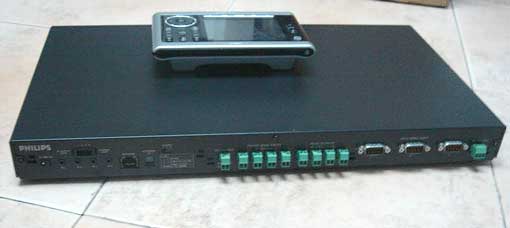One downside to the Pronto 9600's WI-FI
capabilities is that it only has WEP security and it is only 802.11b (i.e.,
only 10 Mbps). So, if you are concerned about your home network's
security, you should be careful and either disable this capability on the
TSU9600, or use it with its own dedicated WI-FI access point.
I received the test unit with two different
extenders. Extenders allow you to control equipment all over the house or
behind opaque cabinet doors.
The RFX9400 is the smallest extender. It can
either be controlled without WI-FI (simple RF, but using the same 2.4 Ghz
frequency range), with WI-FI, or using a wired network connection. You
connect the unit to your network and then program it using a familiar web
based system. Once programmed, the TSU9600 communicates with it and confirms
each operation. You can then tell the unit that a particular device is
extender-based and you can control exactly which IR port the signal will
come out of. There are four IR ports which look like mono headphone jacks.
These can connect to small IR emitters that can be attached to your device's IR sensor. Devices that have IR jacks of their own can simply be linked
using cables that come with the unit.
Reception in my house was fantastic.
It stopped working only when I went down one floor and exited the front
door. Once that happened, the Pronto remote noted that connection loss. It
then refused to proceed to go through a complex macro, because it could not
switch the display on through the extender. This is a very neat solution for
multi-zone control.
The more expensive RFX9600 (shown below) comes in a 1U
rack-ready case. It is able to do quite a lot of additional tricks. Not only
can it control relays (easily accessible through the Pronto professional
software), but it also has current sensing capabilities. In the past, if you
wanted to turn on your entire system, you needed to ensure that each of your
devices had discrete power-on capabilities. Most displays still come with
the annoying power toggle button – press once to turn on and press again to
turn it off. That is very problematic with Pronto designs as the Pronto has
no idea if your display is on or off and so this can really slow you down
and make your Pronto designs overly complex.

The solution is, of course, buy only equipment
with discrete power buttons – one button for on and a different one for
standby. This solution might work with displays, but not necessarily with
more complex devices.
The power sense solution allows you to add
a special connector to the RFX9600, which in turn can be a conditional
command inside your Pronto professional design. When that device is turned
on, it requires much more power than when it is turned off. The sensor is
able to recognize the difference and so only turn on the device if it is
turned off and vice versa (send the power toggle command to turn off the
device only if it senses that it is really turned on).
In addition, you can control relays or even
send RS232 commands in HEX or text format. That lets you control devices
like A/V receivers, home automation systems, computers, A/C systems,
lighting systems, and pretty much anything else you can think of.
The TSU9600 has a long-lasting battery. You
cannot access the battery itself, so I can't tell what kind it is, but after
a full charge, it was able to last almost two days in our household before I
had to put it back in its charging station. That is more than enough for
anyone. The main problem is that if you ever require the battery to be replaced, you
would need to have the unit serviced, as there is no access to the battery
without taking the remote apart (which voids the warranty).
The front of the unit has a smooth
plastic/glass feel to it. Unfortunately, it tended to collect finger prints.
Still, it was much easier to clean than other LCD remotes, due to the flat
concept. After a week of heavy use, it was much cleaner than any other
Pronto remote I have tested.
The 9600 has a nice pickup sensor that
immediately notices when you touch it. It is very sensitive, which means you
don't have to shake the remote to turn it on. It's as if it is reading your
mind: it simply turns on when you start using it. The light button on the
top left part of the remote is essentially useless, and the pickup sensor is a
much more elegant solution.
Conclusions
The Philips Pronto TSU9600 is a tremendous step forward in
terms of functionality and design. It is a really cool product. I hope
that Philips brings out similar devices with smaller form factors, and also that they develop wizard-based software to ensure that the first step
in making the remote usable for home users will be simpler to learn and
easier to use
right out of the box.
- Ofer LaOr -